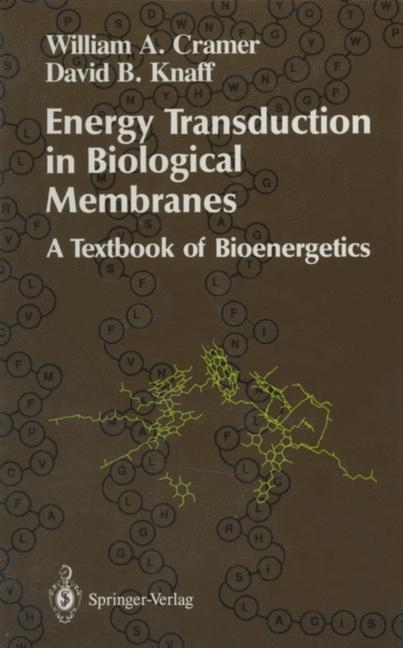
Energy Transduction in Biological Membranes
Springer-Verlag New York Inc.
978-0-387-96761-5 (ISBN)
- Titel ist leider vergriffen;
keine Neuauflage - Artikel merken
I Principles of Bioenergetics.- 1 Thermodynamic Background.- 1.1 Introduction: The First Law of Thermodynamics.- 1.2 Reaction, Direction, Disorder: The Need for the Second Law.- 1.3 On Entropy and the Second Law of Thermodynamics.- 1.4 Maximum Work.- 1.5 Free Energy.- 1.6 Concentration Dependence of the Gibbs Free Energy.- 1.7 Free Energy Change of a Chemical Reaction.- 1.8 Temperature Dependence of Keq.- 1.9 Other Kinds of Work: Electrical, Chemical Work.- 1.10 Thermodynamics of Ion Gradients.- 1.11 Thermodynamics of $$ /Delta {/tilde /mu_{{H^{+} }}} $$-Linked Active Transport.- 1.12 Thermodynamics of $$ /Delta {/tilde /mu_{{H^{+} }}} $$-Linked ATP Synthesis.- 1.13 Nonequilibrium Thermodynamics.- 1.14 “High-Energy” Bonds.- 1.15 Summary.- Problems.- 2 Oxidation-Reduction; Electron and Proton Transfer.- 2.1 Direction of Redox Reactions.- 2.2 The Scale of Oxidation-Reduction Potentials.- 2.3 Oxidation-Reduction Potential as a Group-Transfer Potential; Comparison of Standard Potentials and pK Values.- 2.4 Calculation of the Potential Change for Linked and Coupled Reactions.- 2.5 Concentration Dependence of the Oxidation-Reduction Potential.- 2.6 Experimental Determination of E and Em Values.- 2.7 Factors Affecting the Redox Potential.- 2.8 Redox Properties of Quinones and Semiquinones.- 2.9 Midpoint Potentials of Electrons in Photo-Excited States: Application to Photosynthetic Reaction Centers.- 2.10 Electron Transfer Mechanisms.- 2.11 Proton Transfer Reactions.- 2.12 Summary.- Problems.- 3 Membrane Structure and Storage of Free Energy.- 3.1 Elements of Membrane Structure.- 3.2 Introduction to the Energy Storage Problem.- 3.3 The Chemiosmotic Hypothesis.- 3.4 Measurement of ?pH and ?? Across Energy-Transducing Membranes.- 3.5 Relationship Between ?? and Charge Movement Across the Membrane.- 3.6 Experimental Tests of the Chemiosmotic Hypothesis.- 3.7 A Naturally Occurring Uncoupler: The Uncoupling Protein from Brown Fat Mitochondria.- 3.8 Effect of Uncouplers on Electron Transport Rate.- 3.9 Proton Requirement (H+/ATP) for Reversible ATP Synthase.- 3.10 Storage of Energy in $$ /Delta {/tilde /mu_{{H^{+} }}} $$.- 3.11 Sufficiency of the Chemiosmotic Framework.- 3.12 Appendix. Ionophores.- 3.13 Summary.- Problems.- II Components and Pathways for Electron Transport and H+ Translocation.- 4 Metalloproteins.- 4.1 Heme Proteins, Cytochromes a through d, and o.- 4.2 Occurrence of b Cytochromes.- 4.3 Structure of Cytochrome c.- 4.4 Structure-Function in Mitochondrial Cytochrome c.- 4.5 Residues of Reaction Partners That Are Complementary to Cytochrome c Lysines.- 4.6 Diffusion and Orientability of Cytochrome c.- 4.7 Membrane-Bound c-Type Cytochromes: Cytochromes c1 and f.- 4.8 Copper Proteins: Plastocyanin.- 4.9 Iron-Sulfur Proteins.- 4.10 Membrane-Bound Iron-Sulfur Proteins.- 4.11 The Membrane-Bound FeS-Flavoprotein, Succinate: Ubiquinone Oxidoreductase (Complex II).- 4.12 Summary.- Problems.- 5 The Quinone Connection.- 5.1 Structures, Stoichiometry, Pools, and Branch Points.- 5.2 Reconstitution of Quinone Function Requires Qn with n ? 3.- 5.3 The Quinone Pool Is Located Near the Center of the Membrane Bilayer.- 5.4 The Quinone Connection Across the Center of the Membrane.- 5.5 Quinone Lateral Mobility.- 5.6 The Segregation of Electron Transport Components in Thylakoids Requires Lateral Mobility of Quinone.- 5.7 Quinone-Binding Proteins.- 5.8 Quinone Electron Acceptors in Photosynthetic Reaction Centers.- 5.9 Quinone-Binding Proteins in Photosynthetic Reaction Centers.- 5.10 Summary.- Problems.- 6 Photosynthesis: Photons to Protons.- 6.1 Light Energy Transfer.- 6.2 Use of Energy Transfer as a Spectroscopic Ruler.- 6.3 Light Energy Transfer in Photosynthesis: The Phycobilisome.- 6.4 Structures of Photosynthetic Antenna Pigment-Protein Complexes.- 6.5 Structure of Photosynthetic Reaction Centers.- 6.6 Structure of the Reaction Center Proteins: Transmembrane Charge Separation.- 6.7 Reaction Centers of Plant and Algal PS I and II.- 6.8 Photosynthetic Water Splitting, O2 Evolution, and Proton Release by PS II.- 6.9 The Cyclic and Noncyclic Electron Transfer Chains.- 6.10 Summary.- Problems.- 7 Light and Redox-Linked H+ Translocation: Pumps, Cycles, and Stoichiometry.- 7.1 Introduction.- 7.2 Bacteriorhodopsin, a Well-Characterized Light-Driven H+ Pump.- 7.3 Cytochrome Oxidase (Mitochondrial Complex IV) as a Proton Pump.- 7.4 The Q Cycle and H+ Translocation in Complex III and Chloroplast b6f Complexes.- 7.5 H+ Translocation or Deposition Sites in the Mitochondrial, Chromatophore, and Chloroplast Electron Transport Chains; Stoichiometrics of H+ Translocation and ATP Synthesis.- 7.6 Summary.- Problems.- III Utilization of Electrochemical Ion Gradients.- 8 Transduction of Electrochemical Ion Gradients to ATP Synthesis.- 8.1 Introduction to the Structure and Function of the ATP Synthase.- 8.2 Preparation of H+-ATPase.- 8.3 Structure of F0Fl ATP Synthase.- 8.4 DNA Sequence of Unc Operon.- 8.5 Function of the Membrane-Bound Subunits a, b, and c.- 8.6 Mechanism of ATP Synthesis.- 8.7 Thermodynamic and Kinetic Constants for ATP Hydrolysis.- 8.8 Mechanism of Transduction of $$ /Delta {/tilde /mu_{N{a^{+} }}} $$ to ATP.- 8.9 Other Classes of H+-Translocating ATPases.- 8.10 Summary.- Problems.- 9 Active Transport.- 9.1 Introduction.- 9.2 Evidence for Protein Carrier-Mediated Transport.- 9.3 Techniques for Studying Transport in Bacteria.- 9.4 Structure of the Cell Envelope of Gram-Negative Bacteria.- 9.5 $$ /Delta {/tilde /mu_{N{a^{+} }}} $$ Formation in Bacteria.- 9.6 Active Transport of Sugars Coupled to H+ Cotransport.- 9.7 Kinetic Studies.- 9.8 Structure/Function Considerations.- 9.9 Amino Acid Transport.- 9.10 Sodium-Dependent Transport.- 9.11 Transport Driven by High-Energy Phosphate Intermediates.- 9.12 Periplasmic Transport Systems.- 9.13 Motility.- 9.14 Active Transport in Eukaryotes.- 9.15 Transport or Translocation of Macromolecules.- 9.16 Summary.- Appendix I Answers to Problems.- Appendix II Physical, Chemical, and Biochemical Constants.- Appendix III Prediction of Protein Folding in Membranes.- References.- Glossary of Abbreviations.
| Reihe/Serie | Springer Advanced Texts in Chemistry |
|---|---|
| Zusatzinfo | XIV, 579 p. |
| Verlagsort | New York, NY |
| Sprache | englisch |
| Gewicht | 945 g |
| Themenwelt | Naturwissenschaften ► Biologie ► Biochemie |
| Naturwissenschaften ► Biologie ► Mikrobiologie / Immunologie | |
| Naturwissenschaften ► Biologie ► Zellbiologie | |
| Naturwissenschaften ► Chemie ► Physikalische Chemie | |
| ISBN-10 | 0-387-96761-3 / 0387967613 |
| ISBN-13 | 978-0-387-96761-5 / 9780387967615 |
| Zustand | Neuware |
| Haben Sie eine Frage zum Produkt? |
aus dem Bereich


